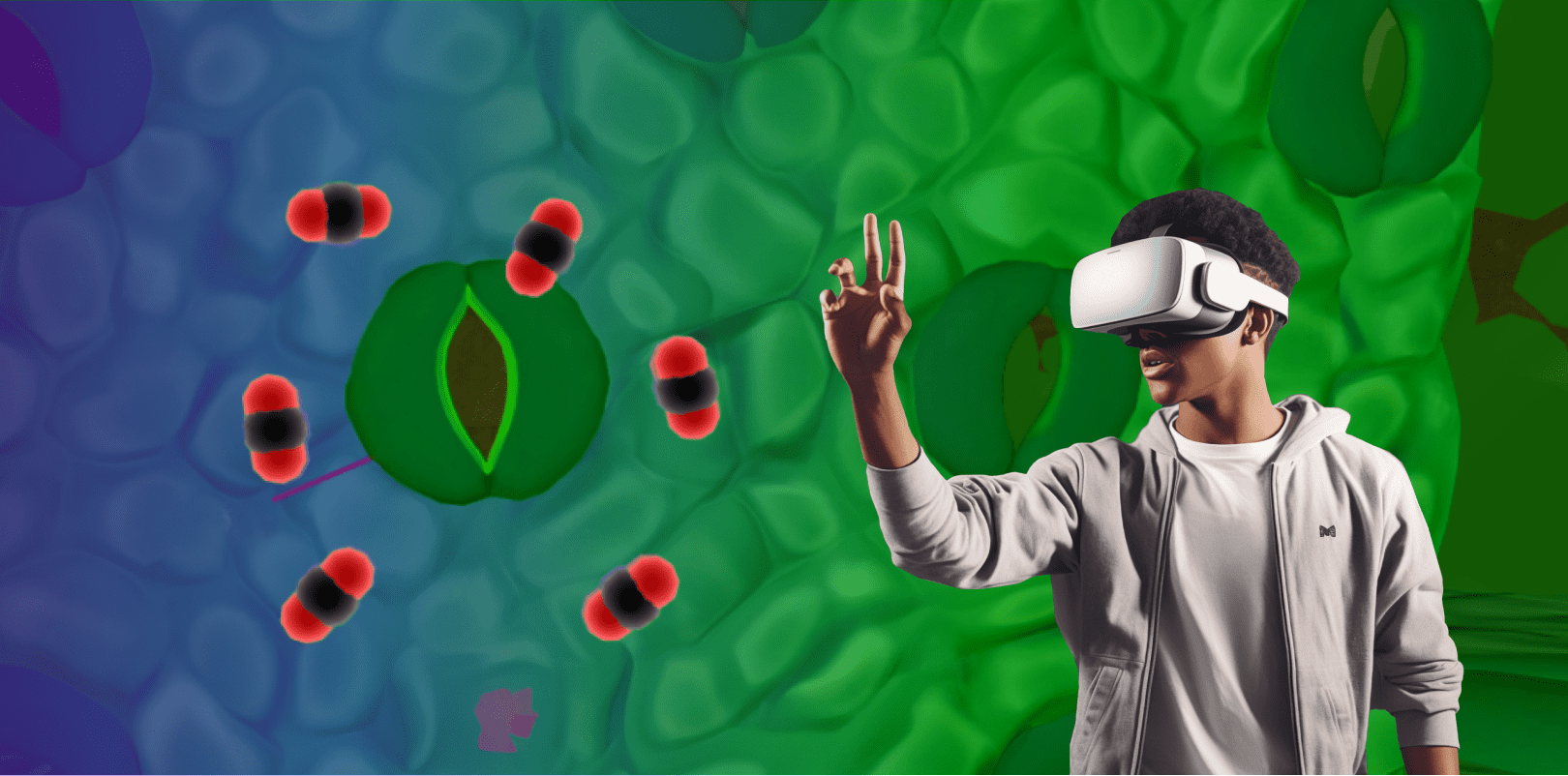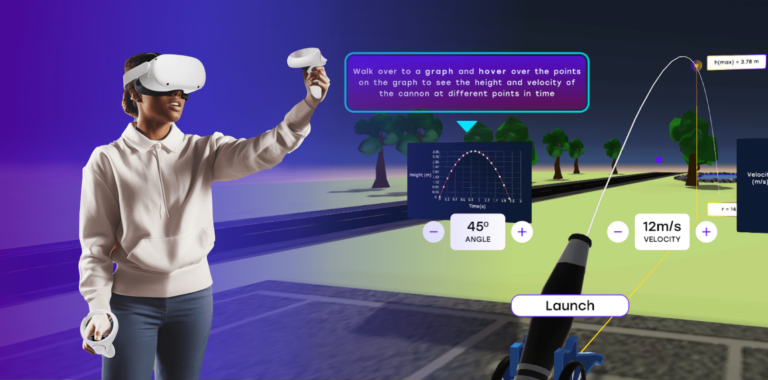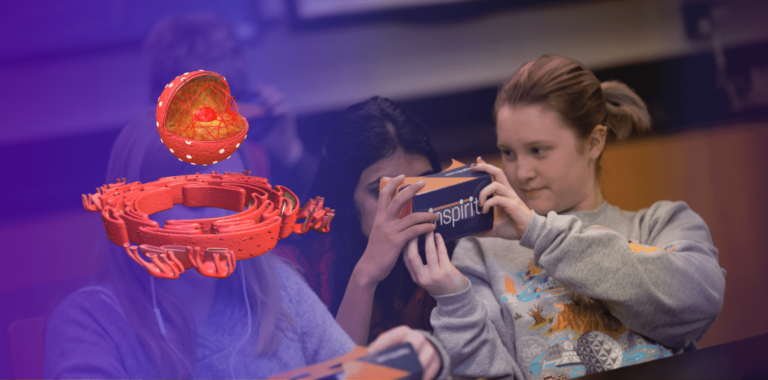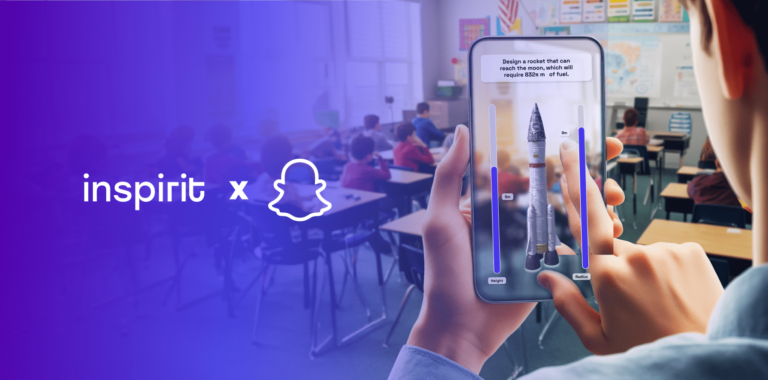Inspiring Future Scientists at Kell High School
Dr. Stovall, who holds a PhD in pharmaceutical and biomedical sciences, is a certified science teacher at Kell High School of Cobb County, Georgia. Her journey from aspiring to create drugs to inspiring young minds in science education showcases her dedication to making learning relevant and impactful. Dr. Stovall upholds an ambitious mission that extends beyond the classroom; she is passionate about increasing diversity among future generations of scientists.
In her quest to combat student apathy and the distractions of smartphones and games, Dr. Stovall has turned to Inspirit’s VR simulations. By integrating immersive simulations on topics like DNA replication, and photosynthesis, plant cell and immune system cells into her class, she has found a powerful tool to captivate her students’ attention. These VR experiences not only reinforce students’ understanding of complex biology concepts but also provide a vivid, immersive way to explore scientific phenomena. Through these virtual explorations, students are not just passive recipients of information but active participants in their learning journey.
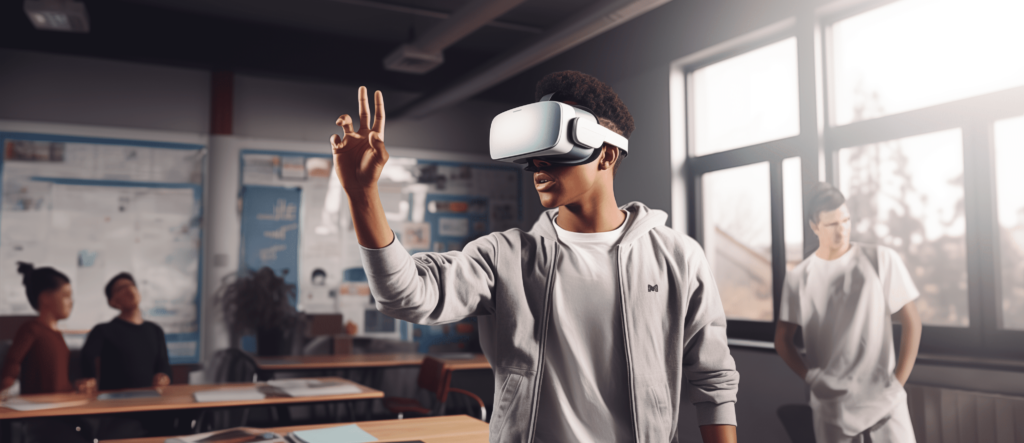
By leveraging the power of Inspirit’s VR simulations, Dr. Stovall’s students are now able to see beyond the textbook and into the microscopic world of biology, fostering a deeper connection with the material. This innovative approach not only retains students’ attention on class materials but also ignites a curiosity and engagement that traditional methods were always struggling with.
Dr. Stovall, a pharmaceutical and biomedical scientist and a
“I think that the majority of teachers would be with me when I say student apathy is at all times High…So getting the attention of the students. It’s kind of the biggest
hurdle in teaching for sure.”
“I think it’s been a great addition to my class. I’ve enjoyed incorporating VR into my class. I see the value in using it. The students are interested and excited about it…being immersed offers an extra layer of connection to what’s actually happening. They’re paying full attention.”
“I know that anytime I have a question, somebody from Inspirit is gonna get right back to me. I love that.”
certified science teacher at Kell High School.
About our Partner
Dr. Kyndra Stovall holds a PhD in pharmaceutical and biomedical sciences. She has an impressive background in medical research and has managed K-12 outreach programs at her institution. However, it was in teaching that Dr. Stovall found her true calling and passion, leading her from the lab to the classroom. She is deeply committed to enriching the diversity of the scientific community and leverages her real-world experiences to make classroom content relevant and engaging for her students. The biggest challenge she had in her teaching experience was “student apathy is at all times high… getting the attention of the students. It’s kind of the biggest hurdle in teaching”. She has been looking for ways to tackle this issue.
In search of innovative solutions, Dr. Stovall participated in several workshops in a STEM Innovation academy program, co-hosted by Cobb County and Inspirit. This program introduced her to the transformative potential of virtual reality (VR) in education, offering her a comprehensive crash course on utilizing VR, augmented reality (AR), and web-based simulations to enhance teaching and learning.
This initial exposure to VR technology, facilitated by Inspirit, not only equipped Dr. Stovall with the practical skills to integrate immersive learning tools into her curriculum but also expanded her vision of what’s possible in education. The support and responsiveness of the Inspirit team have made her venture into VR a seamless and encouraging experience, as Dr. Stovall shared “I know that anytime I have a question, somebody from Inspirit is gonna get right back to me. I love that.” Dr. Stovall is now more excited than ever to explore the “endless possibilities” that VR presents for engaging students and enlivening their learning journey.
The Simulations and the Practice
Last summer term, Dr. Stovall integrated Inspirit’s VR simulations in her biology class and Project Lead the Way class, utilizing simulations on topics like DNA replication, and photosynthesis, plant cell and immune system cells.These VR modules offered students a unique opportunity to delve into the microscopic world of biology, allowing them to visualize and interact with the intricate processes of life at a cellular level. For instance, the DNA replication simulation provided a dynamic visual representation of the replication process, highlighting the roles of enzymes and the formation of the replication fork. Similarly, the photosynthesis module immersed students in the inner workings of a plant cell, elucidating the complex process of converting light energy into sugar.
Dr. Stovall employed a strategic approach to integrate VR into the curriculum, saying “If it’s a concept students find difficult to grasp, particularly if it’s a complex topic, I definitely look to see if there’s a VR simulation that can assist,” thereby prioritizing topics that students typically find challenging. This strategy ensured that VR simulations were used as a powerful tool to enhance understanding of complex biological concepts. The class was organized into small groups, where students alternated between VR exploration and independent work, thereby facilitating personalized learning experiences within the constraints of class size and VR equipment availability.
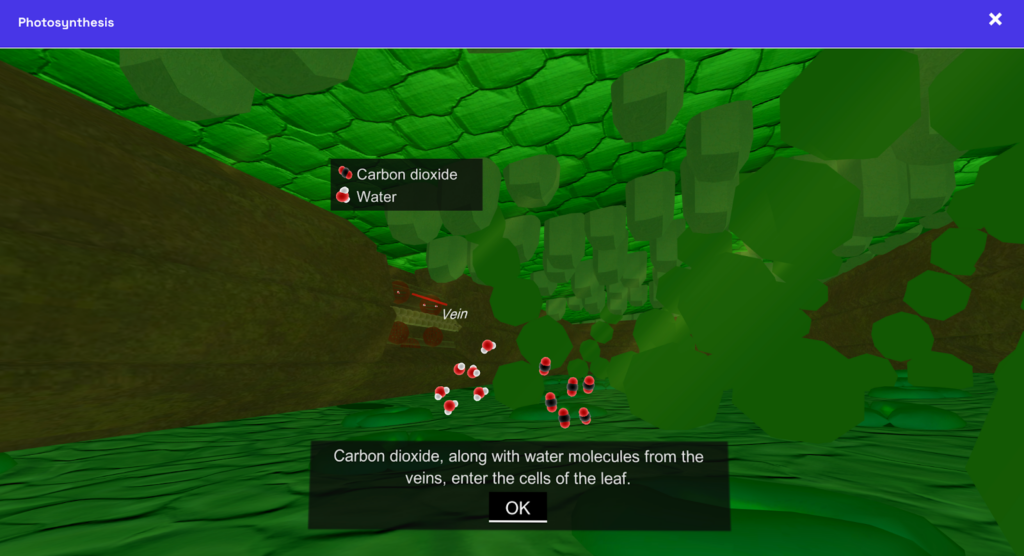
In Dr. Stovall’s class, Inspirit’s VR simulations served as review sessions rather than introductory ones, reinforcing learned concepts through immersive repetition. Dr. Stovall’s pedagogical planning and execution of VR-infused lessons underscored the transformative power of immersive technology in teaching, providing students with a deep and engaging understanding of biology that traditional methods were struggling with. Through this innovative teaching strategy, students were able to visualize and comprehend biological processes in a manner that was both interactive and impactful, demonstrating the profound benefits of integrating VR technology into the science curriculum.
The Learning Affordances and Benefits
01 – Improved Conceptual Understanding
VR simulations, such as the DNA replication module, help students grasp complex biological concepts by visualizing and interacting with processes that are otherwise abstract and difficult to understand. Dr. Stovall emphasizes the effectiveness of VR in making challenging topics like DNA replication more comprehensible, as students can see firsthand how DNA strands are separated and how primers are added.
“It’s hard for the kids to grasp how it works and showing them the video is just not good enough… What I really love about the VR simulation is that it actually demonstrates how DNA is replicated, how the strands are separated, and how the primers are added, making it much more comprehensible for them”
02 – Improved Engagement and Attention Retention
The immersive nature of VR captures and retains students’ attention more effectively than traditional teaching methods. By placing students in the midst of the learning material, VR ensures they are fully engaged and less likely to be distracted by external factors. This heightened engagement is crucial in maintaining student attention and facilitating interest building and deeper understanding.
“It’s a fully immersion… I’m not gonna ignore what’s happening when I’m inside the VR; students ignore video. They can ignore you drawing or kind of half pay attention, but when they’re in it, they’re paying attention to what’s going on”
03 – Enhanced Connection and Relatedness with Content
VR offers an unparalleled avenue for students to engage directly and intimately with educational content, such as the biological process of photosynthesis. Observing these processes in a VR setting goes beyond the capabilities of traditional educational tools like textbooks or diagrams, by offering a hands-on, immersive experience. This not only helps students form a stronger connection and relatedness with the subject matter but also enhances their overall learning experience. Through the lens of Self-Determination Theory (Deci & Ryde, 2012), we understand that such immersive experiences increase students’ intrinsic motivation by fostering a sense of autonomy, competence, and relatedness to the learning material. In essence, the use of VR in education, as exemplified by Dr. Stovall’s approach to teaching, not only enhances students’ intrinsic motivation and enthusiasm for further learning, but also lays a foundational interest in scientific pursuits by making the learning process more engaging and personally relevant. This innovative approach illustrates the transformative power of VR in education, particularly in inspiring future scientists and deepening their interest in complex subjects like the biological sciences.
“”Being immersed in it gives you another sense of… not gonna ignore what’s happening when I’m inside of the VR… being immersed offers an extra layer of connection to what’s actually going on.”
04 – Accessibility to DICE Experiences
Virtual Reality harnesses its distinctive capacity to navigate the DICE model—transforming learning by providing access to experiences that are otherwise Dangerous, Impossible, Counterproductive, or Expensive (Bailsenson, 2018). This technology enables students to delve into the intricacies of microscopic processes. Consequently, VR not only widens the scope of what can be taught and learned but also bridges the gap between abstract concepts and tangible understanding. VR offers richer, immersive, hand-on educational experiences that were previously beyond reach.
““VR gives the students an opportunity to see things that they wouldn’t ordinarily be able to see.
Related Simulations in Physics Subject:
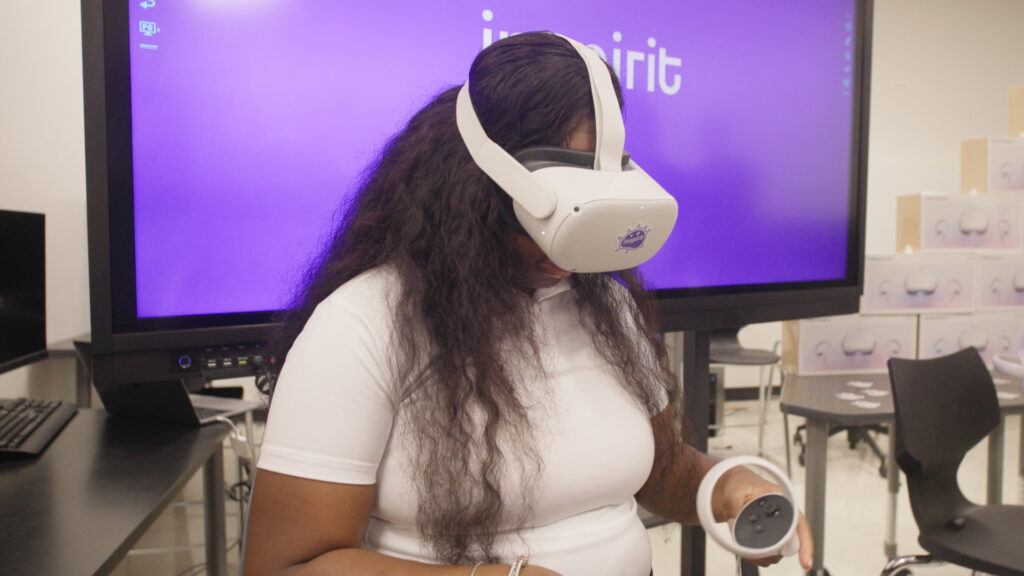
Bring Home the Lab of the Future
- and perform experiments in virtual environments to achieve core science learning outcomes.
- All our experiences run on Oculus Quest and HTC Vive and are built to immerse you in visual realism through real world-scale tracking.
Change the Way You Learn and Interact With Science and Your Surroundings
- Our virtual simulations are a combination of NGSS and State Standards-aligned content and research-based design aimed to redefine experiential learning of the core sciences across the STEM disciplines of Biology, Physics, and Chemistry.
- You can undertake a novel approach to learning through our VR experiences that will change the way you understand and interact with science and your surroundings.
Acknowledgements

Many thanks to Kyndra Stovall, teachers, admins and students at Kell High School.
At Inspirit, Yuqi Wang and the Customer Success team at Inspirit made this case study possible.
Further Readings (Reference)
Bailenson, J.N. (2018). Experience on Demand. New York: W. W. Norton and Company.
Deci, E. L., & Ryan, R. M. (2012). Self-Determination Theory. In P. A. M. Van Lange, A. W. Kruglanski, & E. T. Higgins (Eds.), Handbook of Theories of Social Psychology: Volume 1 (pp. 416-437). Sage Publications.
Gee, J. P. (2003). What video games have to teach us about learning and literacy. Palgrave Macmillan.

